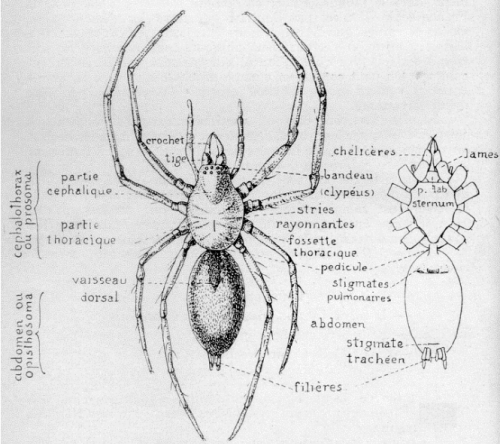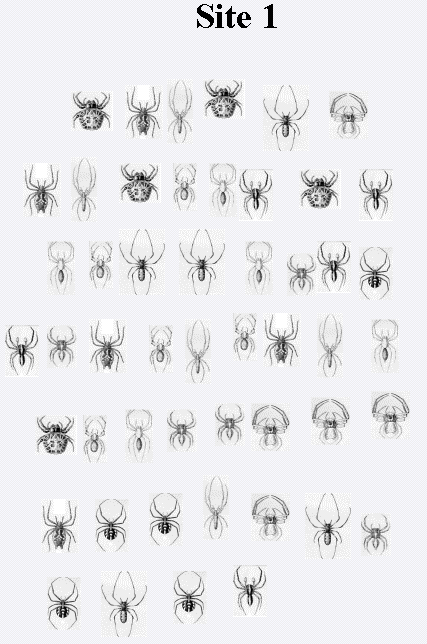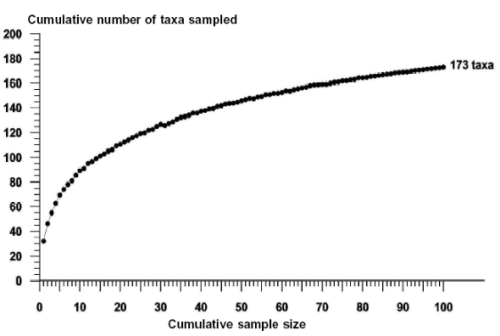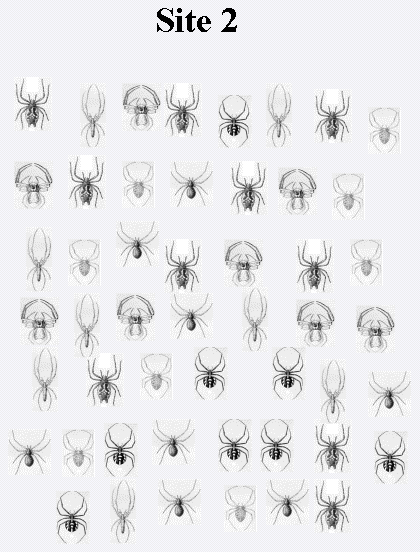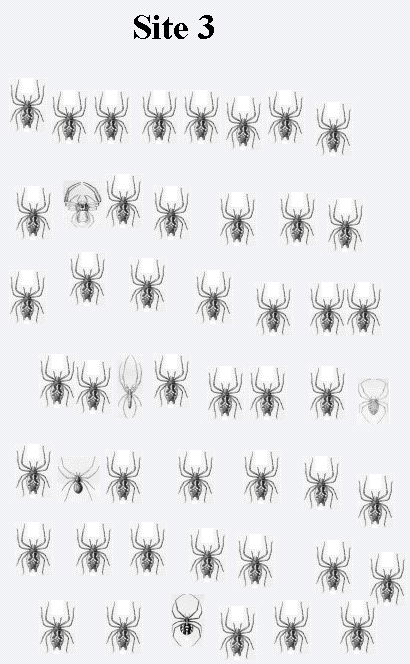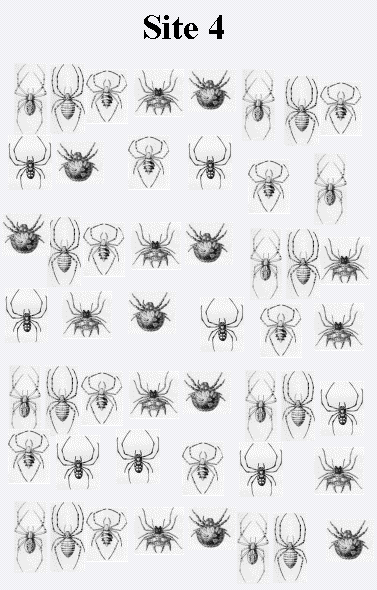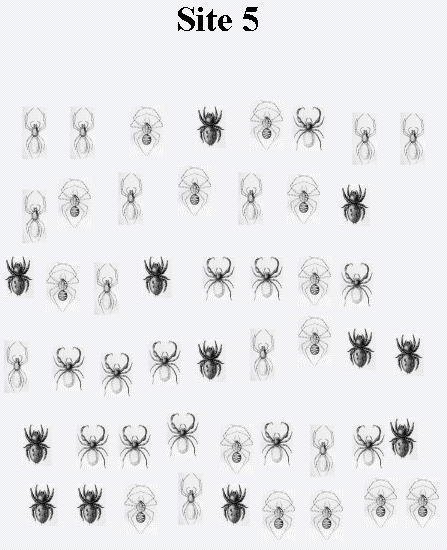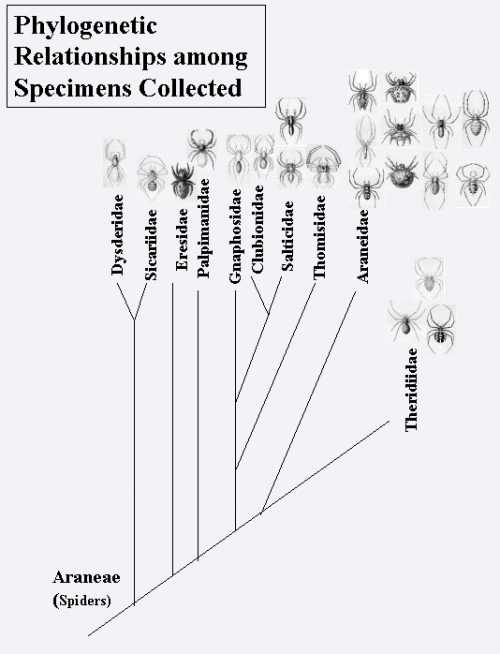Chapter 5. What is Biodiversity? A comparison of spider communities
To explore through classification of life forms the concept of
biological diversity as it occurs at various taxonomic levels.
Spiders are a highly species rich group of invertebrates that
exploit a wide variety of niches in virtually all the earth's
biomes. Some species of spiders build elaborate webs that
passively trap their prey whereas others are active predators
that ambush or pursue their prey. Given spiders' taxonomic
diversity as well as the variety of ecological niches breadth
along with the ease of catching them, spiders can represent
useful, fairly easily measured indicators of environmental
change and community level diversity.
This exercise focuses on classifying and analyzing spider
communities to explore the concept of biological diversity and
experience its application to decision making in biological
conservation. The exercise can be undertaken in three parts,
depending on your interest level.
| Level (1):
You will gain experience in
classifying organisms by sorting a hypothetical collection
of spiders from a forest patch and determining if the
spider collection is adequate to accurately represent the
overall diversity of spiders present in the forest patch.
|
| Level (2):
If you wish to explore further, you
can sort spider collections made at four other forest
patches in the same region and contrast spider communities
in terms of their species richness, species diversity, and
community similarity. You will apply this information to
make decisions about the priority that should be given to
protecting each forest patch in order to conserve the
regional pool of spider diversity.
|
| Level (3):
If you wish to explore the concepts
of biodiversity yet further, you will next take into
account the evolutionary relationships among the families
of spiders collected. This phylogenetic perspective will
augment your decision making about priorities for patch
protection by accounting for evolutionary distinctiveness
in addition to diversity and distinctiveness at the
community level.
|
Once you have worked through these concepts and analyses you
will have a much enhanced familiarity with the subtleties of
what biological diversity is.
Level 1: Sorting and Classifying a Spider Collection and
Assessing its Comprehensiveness
Obtain a paper copy of the spider collection for forest
patch "1." The spiders were captured by a biologist
traveling along transects through the patch and striking a
random series of 100 tree branches. All spiders dislodged
that fell onto an outstretched sheet were collected and
preserved in alcohol. They have since been spread out on a
tray for you to examine. The spider collection is
hypothetical but the species pictured are actual spiders
that occur in central Africa (illustrations used are from
Berland 1955 [link]).
The next task is for you to sort and identify the
spiders. To do this you have to identify all the specimens
in the collection. To classify the spiders look for external
characters that all members of a particular group of spiders
have in common but that are not shared by other groups of
spiders. For example, leg length, hairiness, relative size
of body segments, or abdomen patterning and abdomen shape
all might be useful characters. Look for groups of
morphologically indistinguishable spiders, and describe
briefly the set of characters unique to each group. These
operational taxonomic units that you define will be
considered separate species. To assist you in classifying
these organisms, a diagram of key external morphological
characters of beetles is provided (Figure 5.1). Note that most spider identification
depends on close examination of spider genitalia. For this
exercise, however, we will be examining gross external
characteristics of morphologically dissimilar species.
Assign each species a working name, preferably something
descriptive. For example, you might call a particular
species "spotted abdomen, very hairy" or "short legs, spiky
abdomen" Just remember that the more useful names will be
those that signify to you something unique about the
species. Construct a table listing each species, its
distinguishing characteristics, the name you have applied to
it, and the number of occurrences of the species in the
collection (Figure 5.2).
Last, ask whether this collection adequately represents the
true diversity of spiders in the forest patch at the time of
collection. Were most of the species present sampled or were
many likely missed? This is always an important question to
ask to ensure that the sample was adequate and hence can be
legitimately contrasted among sites to, for example, assign
areas as low versus high diversity sites.
To do this you will perform a simple but informative
analysis that is standard practice for conservation
biologists who do biodiversity surveys. This analysis
involves constructing a so-called collector's
curve (Colwell and Coddington
1994 [link]). These plot the cumulative number of species
observed (y-axis) against the cumulative number of
individuals classified (x-axis). The collector's curve is an
increasing function with a slope that will decrease as more
individuals are classified and as fewer species remain to be
identified (Figure 5.3). If sampling stops
while the collector's curve is still rapidly increasing,
sampling is incomplete and many species likely remain
undetected. Alternatively, if the slope of the collector's
curve reaches zero (flattens out), sampling is likely more
than adequate as few to no new species remain undetected.
To construct the collector's curve for this spider
collection, choose a specimen within the collection at
random. This will be your first data point, such that
X=1
and
Y=1
because after examining the first individual you
have also identified one new species! Next move consistently
in any direction to a new specimen and record whether it is
a member of a new species. In this next step,
X=2
, but Y may remain as
1 if the next individual is not of a new species or it may
change to 2 if the individual represents a new species
different from individual 1. Repeat this process until you
have proceeded through all 50 specimens and construct the
collector's curve from the data obtained (just plot
Y versus
X). Does the curve flatten
out? If so, after how many individual spiders have been
collected? If not, is the curve still increasing? What can
you conclude from the shape of your collector's curve as to
whether the sample of spiders is an adequate
characterization of spider diversity at the site?
Level 2: Contrasting spider diversity among sites to provide
a basis for prioritizing conservation efforts
In this part of the exercise you are provided with spider
collections from 4 other forest patches. The forest patches
have resulted from fragmentation of a once much larger,
continuous forest. You will use the spider diversity
information to prioritize efforts for the five different
forest patches (including the data from the first patch
which you have already classified). Here are the additional
spider collections: (See Figure 5.4, Figure 5.5, Figure 5.6, and Figure 5.7)
Again, tally how many individuals belonging to each species
occur in each site's spider collection (use your
classification of spiders completed for Site 1 during Level 1 of the
exercise). Specifically, construct a table of species (rows)
by site (columns). In the table's cells put the number of
individuals of each species you found in the collection from
the island. You can then analyze these data to generate
different measures of community characteristics to help you
to decide how to prioritize protection of the forest
patches. Recall that you need to rank the patches in terms
of where protection efforts should be applied, and you need
to provide a rationale for your ranking.
You will find it most useful to base your decisions on three
community characteristics: species richness and species
diversity within each forest patch, and the similarity of
spider communities between patches. Species richness is
simply the tally of different spider species that were
collected in a forest patch. Species diversity is a more
complex concept. We will use a standard index called Simpson Reciprocal Index,
 where D is calculated as
follows:
D=∑(pi2)
where
pi
= the fractional abundance of the
ith
species on an island. For example, if you had a sample of
two species with five individuals each,
where D is calculated as
follows:
D=∑(pi2)
where
pi
= the fractional abundance of the
ith
species on an island. For example, if you had a sample of
two species with five individuals each,
 . The higher the value, the greater the
diversity. The maximum value is the number of species in the
sample, which occurs when all species contain an equal
number of individuals. Because this index not only reflects
the number of species present but also the relative
distribution of individuals among species within a community
it can reflect how balanced communities are in terms of how
individuals are distributed across species. As a result, two
communities may have precisely the same number of species,
and hence species richness, but substantially different
diversity measures if individuals in one community are
skewed toward a few of the species whereas individuals are
distributed more evenly in the other community.
. The higher the value, the greater the
diversity. The maximum value is the number of species in the
sample, which occurs when all species contain an equal
number of individuals. Because this index not only reflects
the number of species present but also the relative
distribution of individuals among species within a community
it can reflect how balanced communities are in terms of how
individuals are distributed across species. As a result, two
communities may have precisely the same number of species,
and hence species richness, but substantially different
diversity measures if individuals in one community are
skewed toward a few of the species whereas individuals are
distributed more evenly in the other community.
Diversity is one thing, distinctiveness is quite
another. Thus another important perspective in ranking sites
is how different the communities are from one another. We
will use the simplest available measure of community
similarity, that is, the Jaccard coefficient of community
similarity, to contrast community distinctiveness between
all possible pairs of sites:
 where c is the number of
species common to both communities and
S is the total number of
species present in the two communities. For example, if one
site contains only 2 species and the other site 2 species,
one of which is held in common by both sites, the total
number of species present is 3 and the number shared is 1,
so
1/3=33
%. This index ranges from 0 (when no species are
found in common between communities) to 1 (when all species
are found in both communities). Calculate this index to
compare each pair of sites separately, that is, compare Site 1 with Site 2, Site
1 with Site 3, …,
Site 4 with Site 5 for 10 total comparisons. You
might find it useful to determine the average similarity of
one community to all the others, by averaging the
CCj
values across each comparison a particular site is included.
where c is the number of
species common to both communities and
S is the total number of
species present in the two communities. For example, if one
site contains only 2 species and the other site 2 species,
one of which is held in common by both sites, the total
number of species present is 3 and the number shared is 1,
so
1/3=33
%. This index ranges from 0 (when no species are
found in common between communities) to 1 (when all species
are found in both communities). Calculate this index to
compare each pair of sites separately, that is, compare Site 1 with Site 2, Site
1 with Site 3, …,
Site 4 with Site 5 for 10 total comparisons. You
might find it useful to determine the average similarity of
one community to all the others, by averaging the
CCj
values across each comparison a particular site is included.
Once you have made these calculations of diversity (species
richness and Simpson's Reciprocal Index) you can
tackle the primary question of the exercise: How should you
rank these sites for protection and why? Making an informed
decision requires reconciling your analysis with concepts of
biological diversity as it pertains to diversity and
distinctiveness. What do you recommend?
Level 3: Considering evolutionary distinctiveness
When contrasting patterns of species diversity and community
distinctiveness, we typically treat each species as equally
important, yet are they? What if a species-poor area
actually is quite evolutionarily distinct from others?
Similarly, what if your most species-rich site is comprised
of a swarm of species that have only recently diverged from
one another and are quite similar to species present at
another site? These questions allude to issues of biological
diversity at higher taxonomic levels. Only by looking at the
underlying evolutionary relationships among species can we
gain this additional perspective. We have provided in Figure 5.8 a phylogeny of the spider families that
occur in your collections (a genuine phylogeny for these
families based in large part on Coddington and Levi 1991 [link]). In brief, the
more closely related families (and species therein) are
located on more proximal branches within the
phylogeny. Based on the evolutionary relationships among
these families, will you modify any of the conclusions you
made on prioritizing forest patches for protection based on
patterns of species diversity alone? If so, why?
Berland, L. (1955). Les arachnides de l'Afrique noire francaise. [p. 130]. Dakar: IFAN.
Colwell and J. A. Coddington. (1994). .
Coddington, J. A. and H. W. Levi. (1991). Systematics and evolution of spiders (Araneae). Annual Review of Ecology and Systematics, 22, 565-592.




